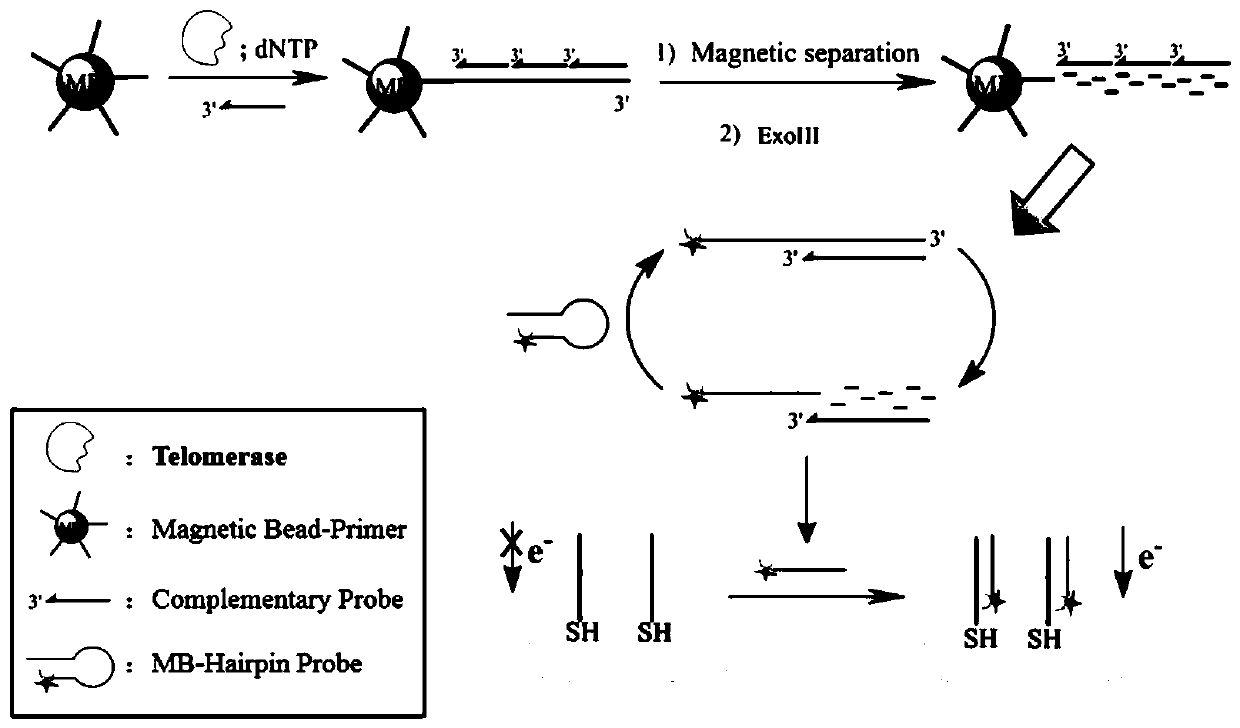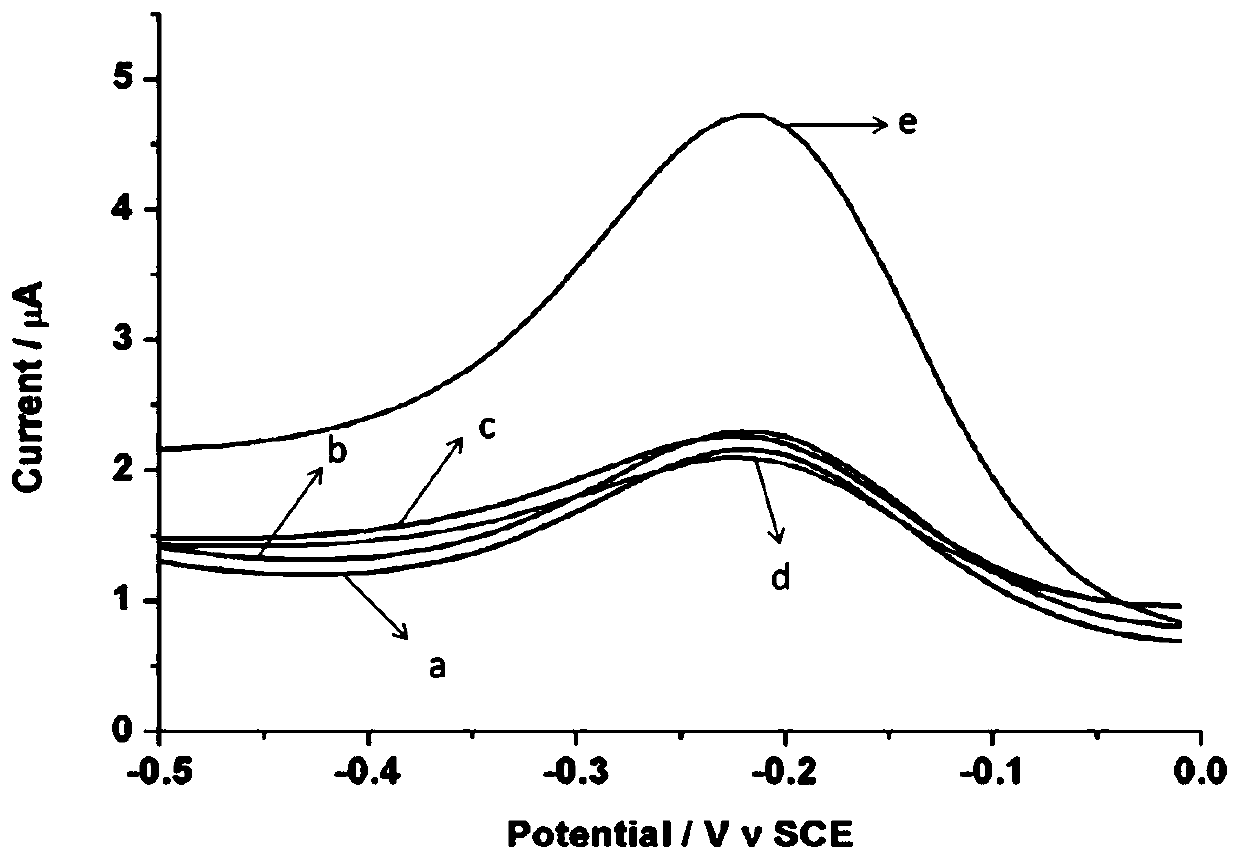Electrochemical sensor for detecting telomerase activity and detection method thereof
A technology of telomerase and electrochemistry, applied in the fields of electrochemical variables of materials, scientific instruments, instruments, etc., can solve the problems of low binding efficiency and enzyme kinetics, limited recognition ability of telomerase, and unfavorable real detection of telomerase. , to avoid the steric hindrance effect, improve the sensitivity, and have a broad application prospect.
- Summary
- Abstract
- Description
- Claims
- Application Information
AI Technical Summary
Problems solved by technology
Method used
Image
Examples
Embodiment 1
[0078] Embodiment 1 is used to detect the preparation method of the electrochemical sensor of telomerase activity
[0079] 1. Cell culture and extraction of telomerase
[0080] (1) HeLa cell culture: 37°C, 5% CO 2 Cultured in DMEM medium containing 10% fetal bovine serum under culture conditions;
[0081] (2) Cell suspension and dispersion treatment: wash the cells in the logarithmic growth phase with PBS, digest with trypsin for 1-3min, and gently blow the cells with PBS buffer to detach them from the surface of the cell culture flask to obtain detached cells;
[0082] (3) Telomerase extraction: collect the detached cells obtained in step (2), centrifuge at 1000rpm for 5min, resuspend with 200μL of frozen 1×CHAPS lysis buffer, and put the lysate containing cells at 4°C , centrifuged at 12000rpm for 30min, collected the supernatant with an Eppendorf tube, and measured the protein concentration with a small part of the supernatant (2μL) under the absolute absorbance at 280nm...
Embodiment 2
[0092] Example 2. Detection of telomerase activity
[0093] 1. The electrochemical method used is alternating current impedance method (EIS). The electrochemical instrument is CHI660D, including a three-electrode system, Ag / AgCl as a reference electrode, and platinum wire as an auxiliary electrode and a gold electrode modified with DNA as a working electrode;
[0094] with 1M KNO 3 5mM [Fe(CN) 6 ] 3- / 4- The solution was carried out, and the EIS experimental parameters: the initial voltage was 0.224V, and the scanning frequency was 0.1Hz-100kHz.
[0095]2. The electrochemical method used is differential pulse voltammetry (DPV), and the electrochemical instrument is CHI660D, including a three-electrode system, Ag / AgCl is a reference electrode, and platinum wire is used as an auxiliary electrode and a gold electrode modified with DNA. Working electrode;
[0096] DPV is carried out in 10mM PBS buffer (PH 7.4), DPV experimental parameters: scanning voltage is -0.5V-0V, pulse a...
experiment example 1
[0098] Feasibility test of experimental example 1 telomerase activity assay
[0099] In this experimental example, differential pulse voltammetry (DPV) is used to verify the feasibility of the method for detecting telomerase activity of the present invention. Such as figure 2 As shown, the DPV current peak showed a significant enhancement in the presence of crude telomerase extract (curve e), indicating the successful synthesis of the repeat sequence (TTAGGG)n on the surface of the magnetic beads and the generation of signal amplification. However, in the absence of telomerase crude extract, the peak DPV current is negligible (curve a), indicating that in the absence of telomerase, the primer cannot be extended further and the complementary sequence has no bound sequence , Exonuclease III cannot be recognized and degraded, and the hairpin-like structure containing MB cannot be opened, nor can it be degraded by Exonuclease III, so that it cannot bind to the capture probe on t...
PUM
 Login to View More
Login to View More Abstract
Description
Claims
Application Information
 Login to View More
Login to View More - R&D
- Intellectual Property
- Life Sciences
- Materials
- Tech Scout
- Unparalleled Data Quality
- Higher Quality Content
- 60% Fewer Hallucinations
Browse by: Latest US Patents, China's latest patents, Technical Efficacy Thesaurus, Application Domain, Technology Topic, Popular Technical Reports.
© 2025 PatSnap. All rights reserved.Legal|Privacy policy|Modern Slavery Act Transparency Statement|Sitemap|About US| Contact US: help@patsnap.com



